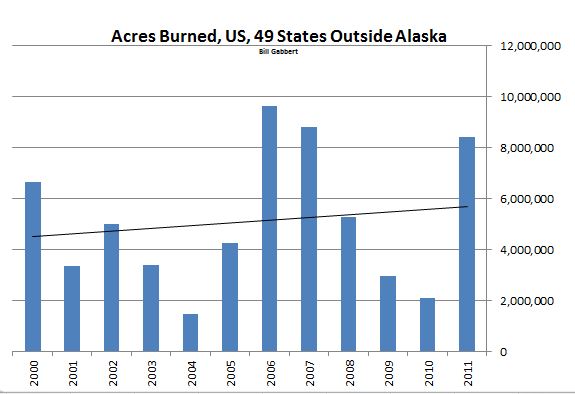The number of unfilled orders for large air tankers increased to 29.8 percent in 2011, while the number of air tankers that were available on contract fell. In 2010 there were 19 large air tankers on exclusive use contracts and the unable to fill (UTF) rate was 15 percent.
In 2011 the number of air tankers decreased to 11 in July after the U.S. Forest Service cancelled their contract with Aero Union saying certain aircraft inspections were not completed. Aero Union, now in the process of selling their assets, is appealing the USFS allegations. Neptune brought on one additional air tanker, a leased BAe-146, in November on an “interim” approval basis.
The higher UTF rate is at least partially due to a busy fire season in the southwest, compared to the slower years of 2009 and 2010. The number of acres burned in the lower 49 states in 2011, which excludes Alaska, was 8.4 million, exceeding the average of 5.1 million between 2000 and 2011.

While the data about UTF rates is difficult to interpret, perhaps we can be safe in saying that if more than 4,000,000 acres burn in the lower 49 states, having 21 or fewer large air tankers tends to result in 25-30% of the air tanker orders being UTF, which is about triple the UTF rate when fewer acres burn. In 2000 with 40 air tankers on contract, 6,600,000 acres burned, and the UTF rate was 7%.
You have to wonder how often incident commanders do not place orders for needed air tankers if they already know that none are available.
UPDATE at 9:00 p.m. MT, January 25, 2012:
We received an email from Scott and we asked him if we could post what he wrote. Here it is:
You wrote “You have to wonder how often incident commanders do not place orders for needed air tankers if they already know that none are available.” This statement is hauntingly similiar to those found in John McLean’s “Fire on the Mountain”, where the author reported airtankers were not ordered during early phase of South Canyon Fire because of assumption “none were available”. The Lesson Learned was don’t assume. Place the orders, justify the need, and push for priority. Still may not get AT, but you tried. Obviously, the reduction in total number AT is ominous for the future. Thanks for keeping it on the front burner.


Yep
Grass fires in the middle of nowhere is a reaction caused by poorly thought out policy making and execution. When we ID that Smokey Bear needs a newer reason other than the “Only you” mantra, then the maybe the reduction of aircraft use MIGHT come into play
Now I do know that acft use might only account for less than 1/3 of total suppression costs…..MAYBE there needs to be a reigning in of other associated costs.
But since approx 1995 there definitely has been an over dependance on airtanker use for every little thing. This coming from a forestry type with a forestry degree, commercial pilots license and a airframe and powerplant license.
Like the ol sayin goes….”Just sayin'”
Maybe with a reduced tanker fleet we will make better decisions as to when to use tankers. Instead of getting one whenever you want, even on grass fires in the middle of nowhere.